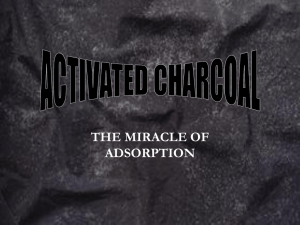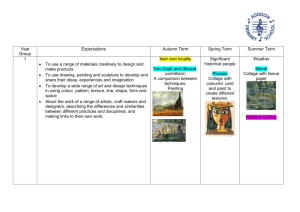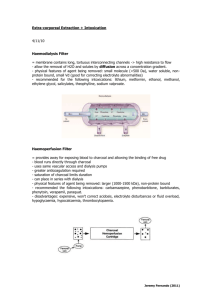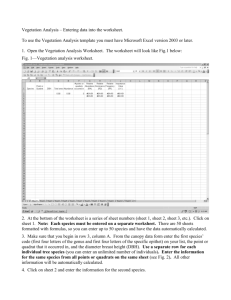User Guide
advertisement
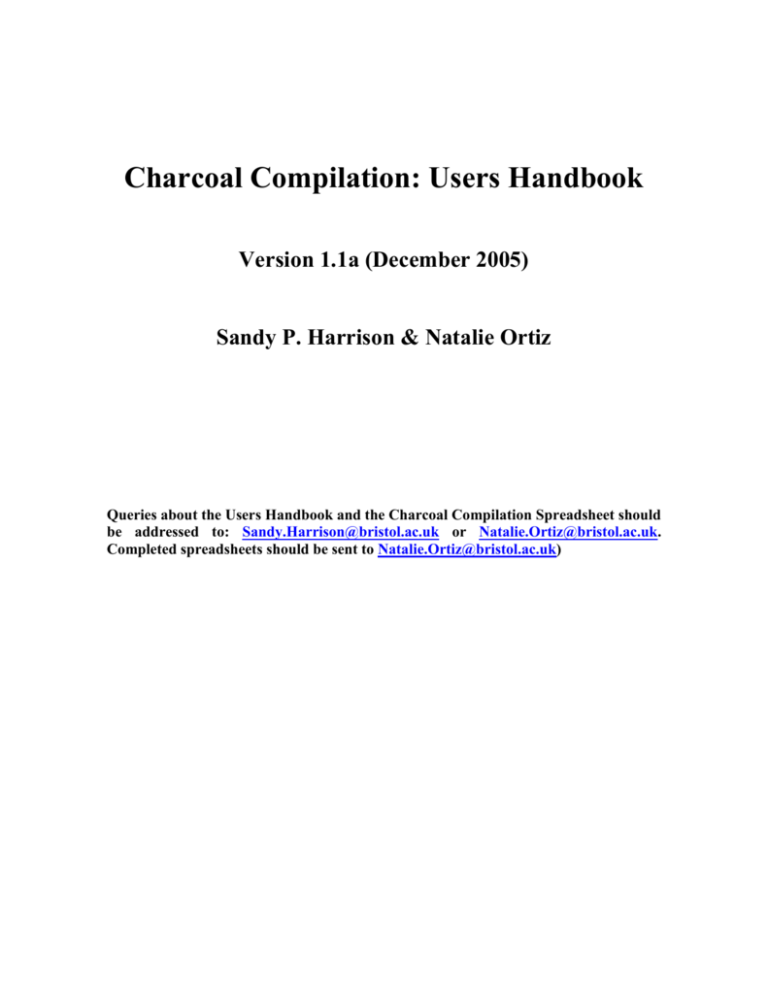
Charcoal Compilation: Users Handbook Version 1.1a (December 2005) Sandy P. Harrison & Natalie Ortiz Queries about the Users Handbook and the Charcoal Compilation Spreadsheet should be addressed to: Sandy.Harrison@bristol.ac.uk or Natalie.Ortiz@bristol.ac.uk. Completed spreadsheets should be sent to Natalie.Ortiz@bristol.ac.uk) Charcoal Compilation: Users Handbook Version 1.1a (December 2005) Sandy P. Harrison & Natalie Ortiz The Excel workbook contains 5 worksheets: 1) Site Metadata (i.e. information about the Site) 2) Sample Metadata (i.e. information about the Sample) 3) Publications 4) Dating Information 5) Charcoal Data There is an additional worksheet that contains lists corresponding to the pull-down lists. This final worksheet MUST NOT BE ALTERED in any way. Note 1: In the descriptions below the term free form field means that you can enter what you want to by way of description, but fields where you have to choose from a set of predesignated options are indicated as having a drop-down list. Note 2: Some fields are linked in the workbook; you enter them on the first worksheet and they will appear automatically where they are required on the subsequent worksheets. Note 3: If the number of Sites exceeds 2.000 or the number of the Samples exceeds 10.000, copy the workbook using other name and continue adding samples in the second workbook. Note 4: The WORKBOOK contains two worked examples, in blue. These examples are not real, but have been made up to illustrate different possibilities for data entries. Please use these as guides only. 1) Site Metadata Worksheet (i.e. information about the Site) Site name This field should give the site name, preferably as given in the original publication. (Free form field) Latitude This field should give latitude expressed in degrees/minutes/seconds or decimal degree expressed as deg.deg., and should be given to as high an accuracy as possible. If you are unable to provide e.g. seconds, please enter this part of the field as 00 (e.g. 84/23/00). Data expressed in degrees/minutes/seconds will be converted to decimal degrees in the final database. There is no need for you to do this here. (Free form field) N/S Choose N (for North) or S (for South) as appropriate (drop-down list) Longitude This field should give longitude expressed in degrees/minutes/seconds or decimal degree expressed as deg.deg, and should be given to as high an accuracy as possible. If you are unable to provide e.g. seconds, please enter this part of the field as 00 (e.g. 84/23/00). Data expressed in degrees/minutes/seconds will be converted to decimal degrees in the final database. There is no need for you to do this here. (Free form field) E/W Choose E (for east) or W (for West) as appropriate (drop-down list) 2 Elevation This is the elevation at the sampling site, given in meters to the nearest whole meter. (Free form field) Site Type This field describes the modern site type (e.g. lake, bog, fluvial valley). There is a drop-down list, adapted from the Global Pollen Data Base, to choose from. Please choose the description that most closely fits the site. If you are unable to match your site, please enter “other”. Water Depth This field is applicable only for lakes. The unit is meters (Free form field) Basin Size This field describes the modern size of the collecting basin in which the charcoal is found. It is therefore only appropriate for lakes and bogs. Basin size should be specified in km2, to the nearest 0.1 km2. In cases where it is impossible to specify the area accurately, please choose a size category from the drop-down list. We recognize 5 size categories: Very small: >0.1 km2 Small: 0.11-1 km2 Medium: 1.1-50 km2 Large: 50.1-500 km2 Very large: >500 km2 (Free form field or drop-down list) Catchment Size This field describes the modern size of the catchment in which charcoal is found. It is therefore only appropriate for lakes, bogs, fluvial deposits. Catchment size should be specified in km2, to the nearest 1 km2. In cases where it is impossible to specify the area accurately, please choose a size category from the drop-down list. We recognize 3 size categories: Small: <10 km2 Medium: 10.1-500 km2 Large: >500 km2 (Free form field or drop-down list) Landscape Description This field describes the landscape setting of the site. There is a drop-down list for you to choose from. Please choose the description that most closely fits the site. We currently recognize the following landscape types: Coastal plain: low-lying setting along a marine coast, with very little relief and a gentle slope towards sea level. Lowland plain: low-lying setting not associated with marine coast, with very little relief and a gentle slope over areas of the order of 500 km2. Upland plain: relatively flat upland (e.g. plateau) with a spatial extent of the order of 500 km2. Rolling upland: upland plain that has vertical relief on the order of 50-100 m but no abrupt topographic transitions. There may be topographically-controlled changes in the vegetation but they do not give rise to spatially-distinct vegetation types. Dissected upland: upland plain that has been heavily dissected by e.g. rivers, such that there are abrupt topographic transitions. There is likely to be considerable vegetation heterogeneity within this landscape type, with radically different vegetation types on the remnant upland and within the dissecting valleys. 3 Lowland river valley: setting within the downstream part of a distinct river valley (i.e. that part of the river which occurs in a lowland setting before reaching the coastal plain). The degree of landscape heterogeneity measured at the site can be expected to vary depending on the size of the river valley, but riverine components are likely to be present; Mountains: highly-dissected landscape within mountain ranges. Basin/range: tectonically-created landscape, with distinct upland and basin elements, and sharp topographic transitions between these elements. The characteristic spatial scale is of the order of tens to hundreds of kilometers. Hummocky/dissected: landscape with considerable vertical relief of the order of 100-500m, but with minimal spatial patterning in the changes of relief. May have been created by deposition (e.g. glacial till deposits) or through aeolian/fluvial erosion. Yedoma: a landscape with small hills and steep-sided plateaus caused by repeated freezing and thawing of ice-rich sediments Marine: the site is in a marine setting or the samples were derived from a marine core. Please note that this describes the current setting and may not reflect the depositional context of the samples. Other: If you are unable to match your site, please enter “other”. Local vegetation This field contains a short description of the modern vegetation around the sampling site (i.e. within ca 1 km or so), and includes information on azonal/intrazonal vegetation, whether the vegetation is heavily anthropomorphized, whether there is natural/human disturbance. The aim of this field is to help us determine whether modern samples form this site are likely to reflect “natural” regional vegetation; (Free form field) Regional vegetation This field contains a short description of the modern vegetation of the region (i.e. within ca 50 km of the site). It corresponds to the natural, undisturbed vegetation type at the level of vegetation formation, major vegetation type or biome; (Free form field) Inflow Only applies to lakes, fluvial category. Select Yes or No (Drop-down list) Outflow Only applies to lakes, fluvial category. Select Yes or No (Drop-down list) Report If you are providing a written report, containing a fuller description of the site, please indicate this by selecting Yes or No (Drop down list). Publication Please give full citation of the publication used to derive Site Metadata in the Publications worksheet, and in this field just write the publication number. (Free form field) 2) Sample Metadata Worksheet (i.e. information about the Sample) Site Name Enter site name (identical to entry in Site Metadata). Please enter this for each sample that you are providing. . (Free form field) Sample Name Enter sample name. Each sample should be given a unique name. This could be a site code plus depth measurement (e.g. S-10 would indicate a sample from Sandy’s Lake at a depth of 10 cm in the core, S-20 would indicate a sample from the same site at a depth of 4 20 cm) or some other designation. Wherever possible, use the same sample codes as in the original publication. (Free form field) Sample Depth Sample depth (in cm) measured from the top of the section or core. Depositional Context This field describes the depositional context of the charcoal record. Please select one from the drop-down list. Only the following fields are allowed: in situ remains; wood; headwater fluvial; fluvial/alluvial; lake sediment; bog sediment; archaeological; buried surface; nests; animal digestive tract; buried organic bed; other; unknown. Please note that this is a standard list that will be applied for parallel syntheses of pollen and plant macrofossil data, and therefore may contain fields that are not applicable for charcoal. The fields are defined as follows: in situ remains: the charcoal was found in growth position (e.g. a tree stump or plant roots in growth position); wood: a fragment of wood not in growth position (e.g. log in lake sediments, wood fragments on existing or former surface); headwater fluvial: charcoal found in fluvial/alluvial deposits in the headwater reaches of a river system, such that we can be sure that it has not been transported more than a few kilometers from where the plants were originally growing; fluvial/alluvial: charcoals found in fluvial/alluvial deposits in the lower reaches of a major river system. These samples may have been transported over some distance to the site and therefore they may not represent the local vegetation; lake sediment: charcoal found in lake deposits, whether from an extant lake or from a stratigraphic section of lake deposits. In both cases, we assume that the material has been transported from the lake catchment or, in the case of aquatics, from surrounding marshes/wetlands; bog sediment: charcoal is found within peat bog deposits. We assume that it is derived from plants growing locally on the surface of the bog; archaeological: charcoals found within an archaeological site and has clearly been brought there by humans (e.g. for firewood, for construction, midden deposits). Thus, not all material found within an archaeological site will automatically be classified as archaeological. For example, if a site was built over a lake and the lake deposits contain aquatic charcoals, these would be classified as “lake sediment”. Similarly, material incorporated in or lying on the natural surface underlying an archaeological site may be classified as “buried surface”; buried surface: charcoal found on or associated with a natural buried land surface. The surface may be associated with a palaeosol or be identified geomorphically or sedimentologically; nests: charcoal found within a nest (e.g. ground squirrel, packrat midden) animal digestive tract: charcoal found within the stomach of a preserved animal (e.g. mammoth). buried organic bed: charcoal found within a buried organic deposit of unknown or unspecified origin; unknown: if the depositional context is not specified in original publication and cannot be determined, please enter unknown; other: if you are unable to match your source, please enter “other”. 5 Collector This is the person(s) who collected the sedimentary material subjected to charcoal analysis. Please give full name and institutional affiliation. (e.g. F. Bloggs, Institute of Archaeology, Moscow) (Free form field) Charcoal Analyst This is the person(s) who made the original charcoal analysis. Please give full name and institutional affiliation. (e.g. F. Bloggs, Institute of Archaeology, Moscow). (Free form field) Synthesis Contact This is the person(s) who is responsible for compiling the data and contributing the data to this synthesis (i.e. you). Please give your name and initials. This information is provided so that we can determine whom to contact if there are queries about specific entries. In the final database, we will add a table with contact details for each contributor, based on our mailing lists. (Free form field) Quantification Type Select from the drop-down list Sample Type Select from the drop-down list the sampling type. Sample size Select a sample size using the drop-down list Publication Please enter the publication(s) on Sheet 3, and then give the appropriate number (or numbers) here. Please make sure to reference both the source of the charcoal data and the source of the chronological information, if these differ. If the same data have been published more than once, only give the first full publication. If the data were published in a language other than English, it would be helpful to provide a translation of the publication title. If the data was subsequently published in an English-language publication, please give this publication as well as the original publication. (Free form field) Estimated Age If the age of a particular sample has been estimated in the literature, please give this value. This may be in the form of a radiometric age on a specific sample (in which case you will give the radiometric age), or it may be in the form of an interpolated age in radiocarbon years. Please do not attempt to give a calibrated age for any sample. Note: these ages are for our guidance only (e.g. to allow quick selection of samples for tests, or to cross-check our age models) and we intend to recalculate age models using a common calibration and methodology. There is therefore NO NEED to enter estimated ages for all samples; only give estimated ages if they are readily available in the literature. If they are not readily available, please leave this column blank. (Free form field) 3) Publications Worksheet Please enter each publication in this worksheet, and transfer the number of the publication into the publication column in Worksheet 1 (Site Metadata) or Worksheet 2 (Sample Metadata). For each publication, please give full citation (including all authors, with initials, year, title, journal, volume, page numbers; for books or chapters in books, please give place of publication). If the title is not in English, it could be helpful to give an English translation of the title. As far as possible, please use the following reference formats: 6 For journal articles: CAPE Project Members (2001) Holocene paleoclimate data from the Arctic: testing models of global climate change. Quaternary Science Reviews 20: 1275-1287 For articles in books: Joussaume S, Taylor KE (2000) The Paleoclimate Modeling Intercomparison Project. In: Braconnot P (Editor), Paleoclimate Modelling Intercomparison Project (PMIP) Proceedings of the third PMIP workshop. WCRP, La Huardière, Canada, 4-8 October 1999, pp. 9-25 For books and reports Wright HE, Kutzbach JE, Webb III T, Ruddiman WF, Street-Perrott FA, Bartlein PJ (Editors) Global climates since the last glacial maximum. University of Minnesota Press, Minneapolis, 569 pp (Free form field) 4) Dating Information Worksheet Please give all the dates available for a given site, including dates that are not used in the construction of age models. Site Name This field is generated automatically from the data entered in Site Metadata. Depth Give depth of dated sample in cm from the top of the core or section. The depth may be given as a range (e.g. 100-110) or as a point (e.g. 100). A range is appropriate for e.g. a bulk radiocarbon date on core sediment. A point may be more appropriate for an AMS date on a single charcoal fragment, shell or macrofossil, a tephra layer or a date based on pollen correlation. (Free form field) Lab Number Give laboratory number, using standard codes for radiometric dates. For e.g. Pb dates, which do not have a standard analysis laboratory code, give sample code form original publication. For tephra layers, please give tephra name from original publication, e.g. Mazama Ash. For pollen correlation dates, please give name of event, e.g. elm decline. (Free form field) Material Dated Specify material dated choose from the drop-down list or specify (Free form field). Age Enter the reported age. For radiocarbon dates, this will be the uncalibrated age. For luminescence dates this will be calendar years. We will use the information in the “Type of date” field to determine which of these options each date represents. Note that it will be possible to enter negative dates (i.e. post-bomb ages) in this field. (Free form field) Positive Error For radiometric dates, enter the reported positive error. This field could be empty for e.g. pollen correlation dates. (Free form field) Negative Error For radiometric dates, enter the reported negative error. This field could be empty for e.g. pollen correlation dates. (Free form field) Type of Date Specify the type of date (e.g. bulk radiocarbon, thermoluminescence, pollen correlation) using the pull-down list. 7 Comments Select a comment about the date using the drop-down list. This field should be left empty if there is no specific comment to be made about the date. 5) Charcoal Data Worksheet Site name This field is generated automatically from the data entered in Sample Metadata worksheet. Sample name This field is generated automatically from the data you have entered in Sample Metadata worksheet. Quantification Type This field is generated automatically from the data you have entered in the Sample Metadata worksheet. Charcoal value Enter a value that represents the amount of charcoal in the sample. (Free form field) Comments Enter any information here that you think may be helpful in interpreting the charcoal data. (Free form field) 8



